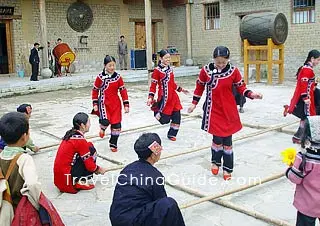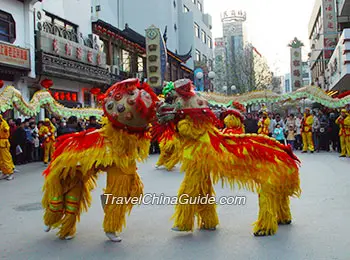Land Based Sports & Activities
Dancing among Bamboo Pole (Tiao Zhugan)
Bamboo Pole Dance is a team activity that can be regarded both as a land based sport and as a dance. On every festive occasion or joyous event, people of the Li ethnic group will gather together in their flamboyant folk costumes to dance, and it is not uncommon for these celebrations to go on throughout the night.
 |
| Bamboo Pole Dance |
Skipping Ropes (Tiaosheng)
Skipping ropes has a long history in China. It is a fun sport for both children and adults. With simply a rope, people have invented many ways to play and to compete. The most common way, also the easiest way for exercise, is to skip once in a round. The speed you can handle either fast or slowly. Usually we can jump 120 - 130 times/ minute. Variety can be wonderful and diverse. A skilled person can turn the rope many times in quick succession while keeping his or her feet off the ground in a single jump. Couples can skip together or with a long rope two people to turn it, a whole group of people is able to join in. In view of its sport effect, now many schools encourage their student to play this game and hold meetings for them. Women in the middle age also welcome it to keep fit.
In view of the beneficial exercise element involved, many schools now encourage their student to play this game and hold meetings for them. Skipping has also been adopted as part of keeping-fit programs by adults.
Lion Dance (Wushi)
This is the wonderful Lion Dance. It brings joy to occasions such as the Chinese New Year, Lantern Festival, wedding celebrations, and opening ceremonies for businesses and so on. Originating in the Northern and Southern Dynasties (386 - 589), the dance became more and more popular during succeeding dynasties. Many famed poets have described the jolly dance scenes in verse.
 |
| Lion Dance |
For this dance, there are two types of lion - those of the north of the Yangtze River and those of Southern China. The northern lions are vivid with golden hair. Dancers will wear clothes to match the lion's color. Usually two dancers cooperate to act as a big lion while another acts as a small lion, such lions dance as a pair. Employing a variety of steps the lion-dancers will express different emotions such as joy, sadness, anger, affection or suspicion and so on. By contrast most Southern lions look quite fierce. In the Huang Feihong Museum for the Art of Lion Dance in Guangdong Province, exhibits record about the stunts of Huang Feihong, the great master of Wushi.
A legend explains the reason for the popularity of the Lion Dance during the Spring Festival. In the early Ming Dynasty, there was a beast that haunted the Foshan area of Guangdong Province and at the end of each year it would appear and do evil things. The people could not bear this any longer so they made models of lions out of bamboo, and painted them in variegated colors. When the beast appeared, they beat gongs and drums, danced with their lions and rushed at the evil beast. On seeing this, the beast ran away in a blue funk. Ever since then local villagers have believed the lion to be an auspicious symbol with which to exorcise evil spirits and the like. The custom of performing a lion-dance continues to this day.